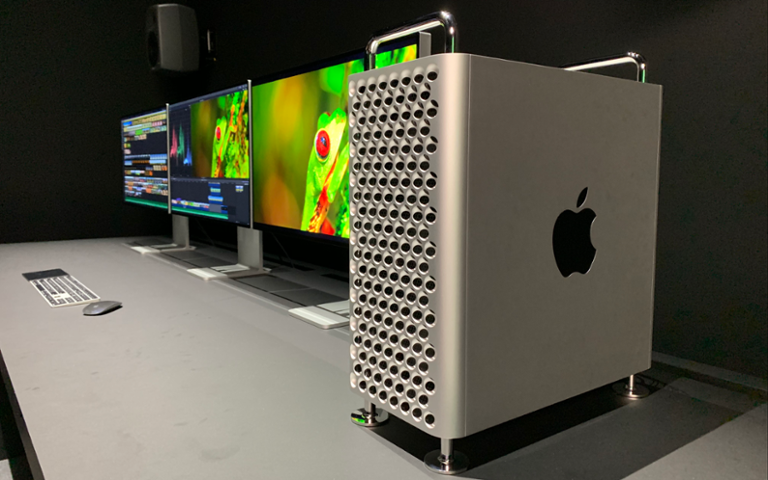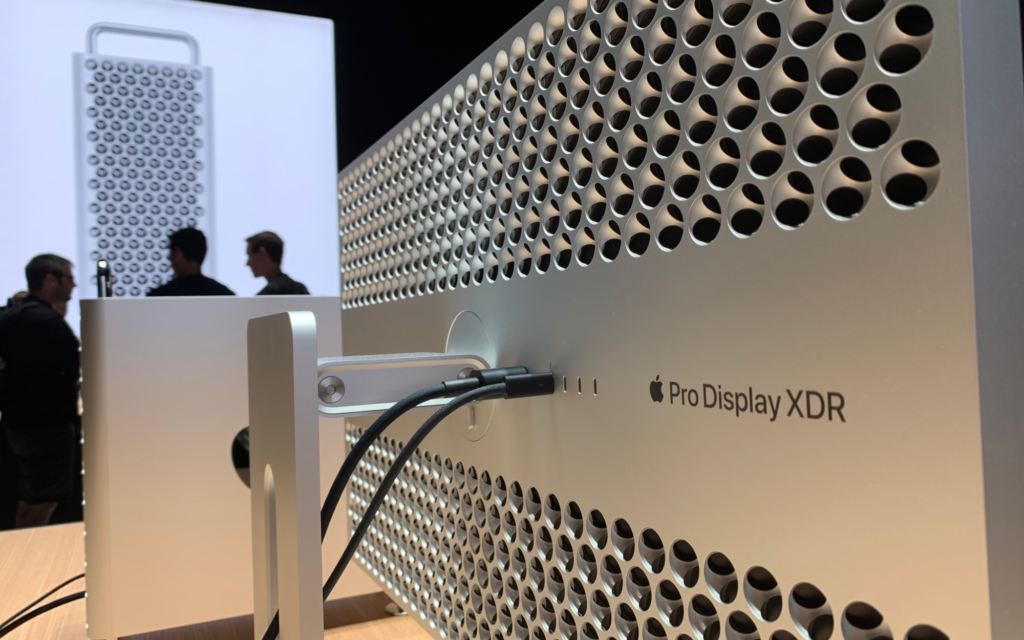
At WWDC 2019, Apple unveiled the new Mac Pro. It’s a beastly machine with an equally impressive display. But should tech professionals focus on it?
During some downtime at WWDC, I popped across the street to see Apple’s new Mac Pro for myself. The company isn’t allowing any hands-on time with the machine yet, but staffers were on-hand to discuss the prowess of Apple’s latest desktop marvel. During this tour, an interesting trend emerged.
Each point of contact with the Mac Pro showed how well-suited it was for ‘creative’ professionals. Video editors and audio engineers in particular are Apple’s focus.
If you’re mixing tracks for an album, or piecing together a big-budget Hollywood hot take on a comic book, the Mac Pro may be exactly what you’re looking for. Its top-end spec sheet is laughably amazing; it’s as if Apple asked these crowds what they wanted, then figured out a way to make it happen without making excuses for the form factor or thermal issues.
Plus, the Mac Pro is a return to the not-over-designed ‘cheese grater’ model. Apple iterated on it rather than try to revisit the ‘trash can’ design, which was flashy and exciting but ultimately terrible. It was specifically terrible for video editors and sound engineers, groups who complained loudly about how much money they sank into the then-new Mac Pro only to see it choke hard on its own design flaws.
In our first piece on the new Mac Pro and Pro Display XDR, we noted it likely wasn’t for you. We’re not going to dissuade you from buying one; if you’ve got $12,000-plus laying around (and need a new desktop computer with a class-leading monitor), by all means treat yo self.
But you probably don’t, and your boss will likely laugh you out of their office if you try to requisition one for your desk. Now what?
The iMac Pro is still here, and probably a much cleaner fit for tech professionals. It’s an all-in-one with an impressive screen, the same dark keyboard/trackpad as the Mac Pro, and can be upgraded to suit just about anyone in the tech space. If we can take umbrage with any aspect of the iMac Pro, it’s that Apple didn’t design it to be upgradeable.
We’d like to think the excitement around the Mac Pro at WWDC shows Apple that the modularity of a ‘pro’ machine is enticing to developers and engineers, too. We’d also like to think the next iMac Pro will be ever-so-slightly redesigned to allow modularity and upgrading.

It’s important to note that when we consider ‘upgrading’ a computer, it’s typically memory or RAM, and maybe a GPU. These are things an iMac Pro could accommodate; the machine would be bulkier, but I am willing to bet that’s a tradeoff most developers would be okay with.
(At Apple’s Mac Pro showcase, a lone iMac Pro sat in the corner; a staffer was there, waiting for someone (anyone!) to come talk to them about it. Nobody did. It’s hard to care when the iMac Pro is next to a Mac Pro controlling a massive robot arm, and two other staffers next to Mac Pros running three Pro Displays at once.)
What the Mac Pro tells us is Apple is keenly aware who ‘pros’ are, and that not any one machine will be suitable for the whole lot of us. The bottom-end Mac Pro is $6,000, and it’s great... but is it good enough that you would rather have it than an iMac Pro or MacBook Pro, which can be had with similar or better specs (depending on your needs, of course)?
The Mac Pro is meant to sit under a desk, absolutely murdering pixels and audio streams. For developers, it’s overkill on almost every level. And we should consider what ‘modular’ means, here; the beastly GPUs, for instance, are housed in a special Mac Pro unit. You can’t quite take a screwdriver to this machine like some old PC.
I’d argue Apple is strictly focused on ‘pro’ hardware now, and anything less than ‘pro’ better be a hit. Case in point: the MacBook. It hasn’t really seen a form-factor upgrade since it launched in 2015. The MacBook Air was recently relaunched after lingering for years with a bad screen and creaky old design.
The Mac Mini is also around, last refreshed in October 2018. Like the MacBook Air, it went a long time without any attention. Like the iMac Pro and MacBook Pro, it can’t be upgraded after purchase; once you buy, you’re all-in.
Apple's Lingering Hardware Issues
Two issues linger for Apple. It tends to let hardware hang too long on the vine, and its keyboards for the MacBook lineup have deep issues. It's been over 700 days since the MacBook was upgraded in a meaningful way, and the Mac Pro went nearly 2,000 days before Apple addressed it at WWDC 2019. (The iMac Pro is now two years old, but has received spec updates periodically; the problem is this only helps new purchases, as existing machines can’t be upgraded.)
I wish I could talk the Mac Pro up for tech professionals, but I can’t. That’s disingenuous. You should be looking at the iMac Pro, or a MacBook Pro along with a Thunderbolt display for desktop use. If your argument is “but my compile times!”, a Mac Pro won’t solve that for you. Better code will, and Apple just introduced SwiftUI and is packaging apps differently for just that reason.
The Mac Pro is enticing, and the base model is powerful and intriguing. You’d be kidding yourself if you thought you’d be happy with it plugged into a Dell monitor, though. The “real” cost of Apple’s best-in-class desktop experience is well into five figures, and that’s just daunting. You’re also likely not the kind of pro who needs all that. (Besides, the iMac Pro comes in dark mode, and that’s way cooler.)
When we first got wind of the new Mac Pro back in April 2018, I wrote “assume the modular 2019 Mac Pro will be geared toward professionals who don’t write apps or software services.” Hate to say I told you so, but…


